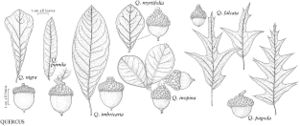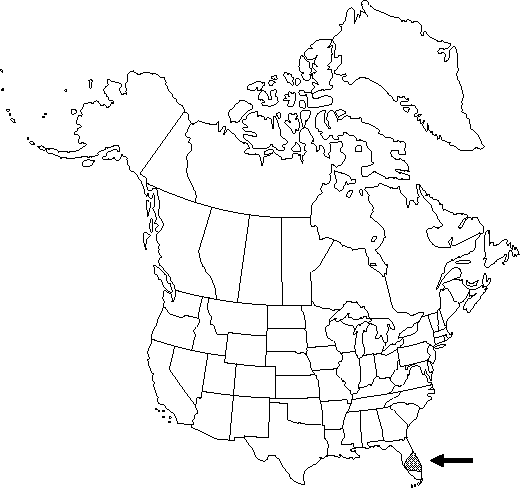Difference between revisions of "Quercus inopina"
Rhodora 31: 79. 1929.
FNA>Volume Importer |
imported>Volume Importer |
||
| (7 intermediate revisions by 2 users not shown) | |||
| Line 12: | Line 12: | ||
}}{{Treatment/ID/Special_status | }}{{Treatment/ID/Special_status | ||
|code=F | |code=F | ||
| − | |label= | + | |label=Illustrated |
}} | }} | ||
|basionyms= | |basionyms= | ||
| Line 23: | Line 23: | ||
}}<!-- | }}<!-- | ||
| − | --><span class="statement" id="st- | + | --><span class="statement" id="st-undefined" data-properties=""><b>Shrubs,</b> evergreen, to 5 m. <b>Bark</b> gray. <b>Twigs</b> light to dark purplish brown, (1.5-)2-3(-4) mm diam., glabrate to sparsely pubescent, especially at apex. <b>Terminal</b> buds dark purplish brown, ovoid to subconic, 2-6 mm, noticeably 5-angled in cross section, glabrous to tawny strigose on apical 1/3. <b>Leaves</b>: petiole 1.5-8.5 mm, glabrous, occasionally sparsely pubescent. <b>Leaf</b> blade ovate or elliptic to obovate, occasionally spatulate, (25-)45-85 × (15-)25-45 mm, base acute to rounded or cordate, margins entire, strongly revolute, with 1 apical awn, apex obtuse or rounded; surfaces abaxially yellow-scurfy, occasionally somewhat pubescent, rarely glabrous, adaxially distinctly convex, rugose, glabrous or with scattered hairs, especially along midrib and at base. <b>Acorns</b> biennial; cup cup-shaped to bowl-shaped, 6-8 mm high × 10-15 mm wide, covering 1/3-1/2 nut, outer surface puberulent, inner surface half to fully pubescent, scale tips tightly appressed, acute; nut ovoid to broadly ellipsoid, 10-14 × 9-13 mm, glabrate, scar diam. 4.5-8 mm.</span><!-- |
-->{{Treatment/Body | -->{{Treatment/Body | ||
| Line 30: | Line 30: | ||
|elevation=0-50 m | |elevation=0-50 m | ||
|distribution=Fla. | |distribution=Fla. | ||
| − | |discussion=<p>Quercus inopina occurs from Orange County, Florida, southwest to Manatee County and south to Martin County. It flowers one to two weeks later than Q. myrtifolia (A. F. Johnson and W. G. Abrahamson 1982).</p><!-- | + | |discussion=<p><i>Quercus inopina</i> occurs from Orange County, Florida, southwest to Manatee County and south to Martin County. It flowers one to two weeks later than <i>Q. myrtifolia</i> (A. F. Johnson and W. G. Abrahamson 1982).</p><!-- |
--><p>The leaves of this species often have numerous small black dots on the adaxial surface. These are ascocarps (the sexual fruiting bodies of ascomycete fungi) of the genus Asterina (D. M. Hunt, pers. comm).</p><!-- | --><p>The leaves of this species often have numerous small black dots on the adaxial surface. These are ascocarps (the sexual fruiting bodies of ascomycete fungi) of the genus Asterina (D. M. Hunt, pers. comm).</p><!-- | ||
| − | --><p>Although no hybrids have been formally described, evidence of hybridization of Quercus inopina with Q. hemisphaerica, Q. laevis, and Q. myrtifolia has been reported (D. M. Hunt 1989).</p> | + | --><p>Although no hybrids have been formally described, evidence of hybridization of <i>Quercus inopina</i> with <i>Q. hemisphaerica</i>, <i>Q. laevis</i>, and <i>Q. myrtifolia</i> has been reported (D. M. Hunt 1989).</p> |
|tables= | |tables= | ||
|references= | |references= | ||
| Line 41: | Line 41: | ||
-->{{#Taxon: | -->{{#Taxon: | ||
name=Quercus inopina | name=Quercus inopina | ||
| − | |||
|authority=Ashe | |authority=Ashe | ||
|rank=species | |rank=species | ||
| Line 55: | Line 54: | ||
|publication title=Rhodora | |publication title=Rhodora | ||
|publication year=1929 | |publication year=1929 | ||
| − | |special status=Endemic; | + | |special status=Endemic;Illustrated |
| − | |source xml=https:// | + | |source xml=https://bitbucket.org/aafc-mbb/fna-data-curation/src/2e0870ddd59836b60bcf96646a41e87ea5a5943a/coarse_grained_fna_xml/V3/V3_58.xml |
|genus=Quercus | |genus=Quercus | ||
|section=Quercus sect. Lobatae | |section=Quercus sect. Lobatae | ||
|species=Quercus inopina | |species=Quercus inopina | ||
| − | |||
| − | |||
| − | |||
| − | |||
| − | |||
| − | |||
| − | |||
| − | |||
| − | |||
| − | |||
| − | |||
| − | |||
| − | |||
| − | |||
| − | |||
| − | |||
| − | |||
| − | |||
| − | |||
| − | |||
| − | |||
| − | |||
| − | |||
| − | |||
| − | |||
| − | |||
| − | |||
| − | |||
| − | |||
| − | |||
| − | |||
| − | |||
| − | |||
| − | |||
| − | |||
| − | |||
| − | |||
| − | |||
| − | |||
}}<!-- | }}<!-- | ||
-->[[Category:Treatment]][[Category:Quercus sect. Lobatae]] | -->[[Category:Treatment]][[Category:Quercus sect. Lobatae]] | ||
Latest revision as of 22:49, 5 November 2020
Shrubs, evergreen, to 5 m. Bark gray. Twigs light to dark purplish brown, (1.5-)2-3(-4) mm diam., glabrate to sparsely pubescent, especially at apex. Terminal buds dark purplish brown, ovoid to subconic, 2-6 mm, noticeably 5-angled in cross section, glabrous to tawny strigose on apical 1/3. Leaves: petiole 1.5-8.5 mm, glabrous, occasionally sparsely pubescent. Leaf blade ovate or elliptic to obovate, occasionally spatulate, (25-)45-85 × (15-)25-45 mm, base acute to rounded or cordate, margins entire, strongly revolute, with 1 apical awn, apex obtuse or rounded; surfaces abaxially yellow-scurfy, occasionally somewhat pubescent, rarely glabrous, adaxially distinctly convex, rugose, glabrous or with scattered hairs, especially along midrib and at base. Acorns biennial; cup cup-shaped to bowl-shaped, 6-8 mm high × 10-15 mm wide, covering 1/3-1/2 nut, outer surface puberulent, inner surface half to fully pubescent, scale tips tightly appressed, acute; nut ovoid to broadly ellipsoid, 10-14 × 9-13 mm, glabrate, scar diam. 4.5-8 mm.
Phenology: Flowering spring.
Habitat: On deep white "sugar" sands of low sandhill ridges, scrub communities, and flat upland terraces
Elevation: 0-50 m
Discussion
Quercus inopina occurs from Orange County, Florida, southwest to Manatee County and south to Martin County. It flowers one to two weeks later than Q. myrtifolia (A. F. Johnson and W. G. Abrahamson 1982).
The leaves of this species often have numerous small black dots on the adaxial surface. These are ascocarps (the sexual fruiting bodies of ascomycete fungi) of the genus Asterina (D. M. Hunt, pers. comm).
Although no hybrids have been formally described, evidence of hybridization of Quercus inopina with Q. hemisphaerica, Q. laevis, and Q. myrtifolia has been reported (D. M. Hunt 1989).
Selected References
None.

